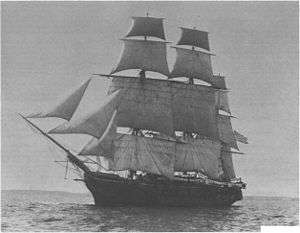Africa Squadron
Note: For earlier Royal Navy anti-slavery squadron see West Africa Squadron
| Africa Squadron | |
|---|---|
 A photograph of the sloop-of-war USS Jamestown (date unknown). She captured two slave ships with the Africa Squadron. | |
| Active | 1819–1861 |
| Country | |
| Branch | |
| Type | Naval squadron |
| Role | African Slave Trade Patrol |
The Africa Squadron was a unit of the United States Navy that operated from 1819 to 1861 to suppress the slave trade along the coast of West Africa. However, the term was often ascribed generally to anti-slavery operations during the period leading up to the American Civil War.
The squadron was an outgrowth of the 1819 treaty between the United States and the United Kingdom that was an early step in stopping the trade, and further defined by the Webster–Ashburton Treaty of 1842. Although technically coordinated with a British West Africa Squadron based in Sierra Leone, in practice the American contingent worked on its own. The squadron also lacked support from the navy itself: Secretary of the Navy Abel Parker Upshur (1790–1844) was a Southerner and an extreme supporter of states' rights and slavery, and assigned only a handful of ships mounting a total of 80 guns between them.
Matthew Perry was the first commander of the squadron, and based himself in Portuguese Cape Verde.
The squadron was generally ineffective, since the ships were too few, and since much of the trading activity had shifted to the Niger River delta area (present-day Nigeria), which was not being covered. In the two years of Perry's leadership, only one slaver was reported to have been captured, and that ship was later acquitted by a New Orleans court. In the 16 years of squadron operation, only the crews of 19 slave ships went to trial. These slavers were acquitted or only lightly fined. Other commanders, however, were more successful.
African slave trade patrol
The Africa Squadron's cruising area eventually ranged from Cape Frio to the south (about 18 degrees south latitude), to Madeira in the north. However, the squadron's supply depot was in Cape Verde archipelago, approximately 2500 miles from the northern-most centers of the slave trade in the Bight of Biafra and southward. The navy department did not move the depot location until 1859, when it was set up at São Paulo de Luanda, in Portuguese Angola, about eight degrees south latitude. At the same time the department put Madeira out of bounds for the squadron.
The majority of the squadron's cruising in its first decade was along the coast of Western Africa, with particular attention to Liberian interests. By the 1850s much of the slave trade in this area had been eliminated by the British, based in their colony at Sierra Leone, as well as the Liberians.
Vessels seized
Africa Squadron
| Vessel | Captor | Date | Location |
|---|---|---|---|
| Uncas | Porpoise | 1 March 1844 | Gallinas |
| Spitfire | Truxtun | 24 March 1845 | Pongas R. |
| Patuxent | Yorktown | 27 September 1845 | Cape Mount |
| Pons | Yorktown | 30 September 1845 | Kabenda |
| Merchant | Jamestown | 3 December 1845 | Sierra Leone |
| Panther | Yorktown | 15 December 1845 | Kabenda |
| Robert Wilson | Jamestown | 15 January 1846 | Porto Praya |
| Malaga | Boxer | 13 April 1846 | Kabenda |
| Casket | Marion | 2 August 1846 | Kabenda |
| Chancellor | Dolphin | 10 April 1847 | Cape Palmas |
| Excellent | John Adams | 23 April 1850 | Ambriz |
| Martha | Perry | 6 June 1850 | Ambriz |
| Chatsworth | Perry | 11 September 1850 | Ambriz |
| Advance | Germantown | 3 November 1852 | Porto Praya |
| R.P. Brown | Germantown | 23 January 1853 | Porto Praya |
| H.N. Gambrill | Constitution | 3 November 1853 | Kongo |
| Glamorgan | Perry | 10 March 1854 | Kongo |
| W.G. Lewis | Dale | 6 November 1857 | Kongo |
| Brothers | Marion | 8 September 1858 | Mayumba |
| Julia Dean | Vincennes | 28 December 1858 | Cape Coast Castle |
| Orion | Marion | 21 April 1859 | Kongo |
| Ardennes | Marion | 27 April 1859 | Kongo |
| Emily | Portsmouth | 21 September 1859 | Loango |
| Delicia | Constellation | 21 September 1859 | Kabenda |
| Virginian | Portsmouth | 6 February 1860 | Kongo |
| Falmouth | Portsmouth | 6 May 1860 | Porto Praya |
| Thomas Achorn | Mystic | 29 June 1860 | Kabenda |
| Triton | Mystic | 16 July1860 | Loango |
| Erie | Mohican | 8 August 1860 | Kongo |
| Storm King | San Jacinto | 8 August 1860 | Kongo |
| Cora | Constellation | 26 September 1860 | Kongo |
| Bonito | San Jacinto | 10 October 1860 | Kongo |
| Express | Saratoga | 25 February 1861 | Possibly Loango |
| Nightingale | Saratoga | 21 April 1861 | Kabenda |
| Triton | Constellation | 20 May 1861 | Kongo |
| Falmouth | Sumpter | 14 June 1861 | Kongo |
Source: Canney, D.L., Africa Squadron, Potomac Books, 2006, pp. 233–234
See also
References
- Richard Andrew Lobban, Jr. and Peter Karibe Mendy, Historical Dictionary of the Republic of Guinea-Bissau, 3rd ed. (Scarecrow Press, 1997 ISBN 0-8108-3226-7) pp. 66–68
- Canney, Donald L. (2006). Africa Squadron: The U.S. Navy and the Slave Trade, 1842-1861. Washington, D.C.: Potomac. ISBN 9781597974646.